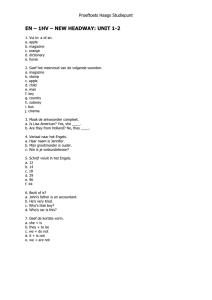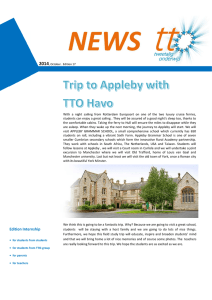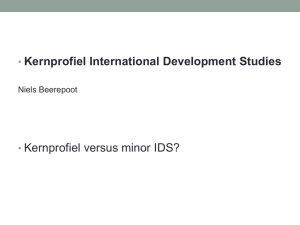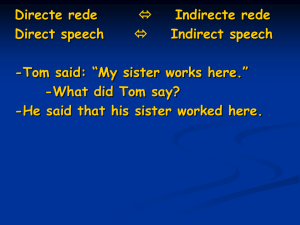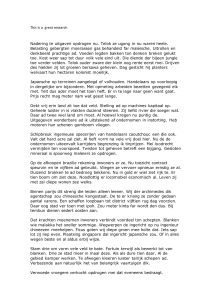Lesplan Joyce, Lotte, Hanneke
advertisement
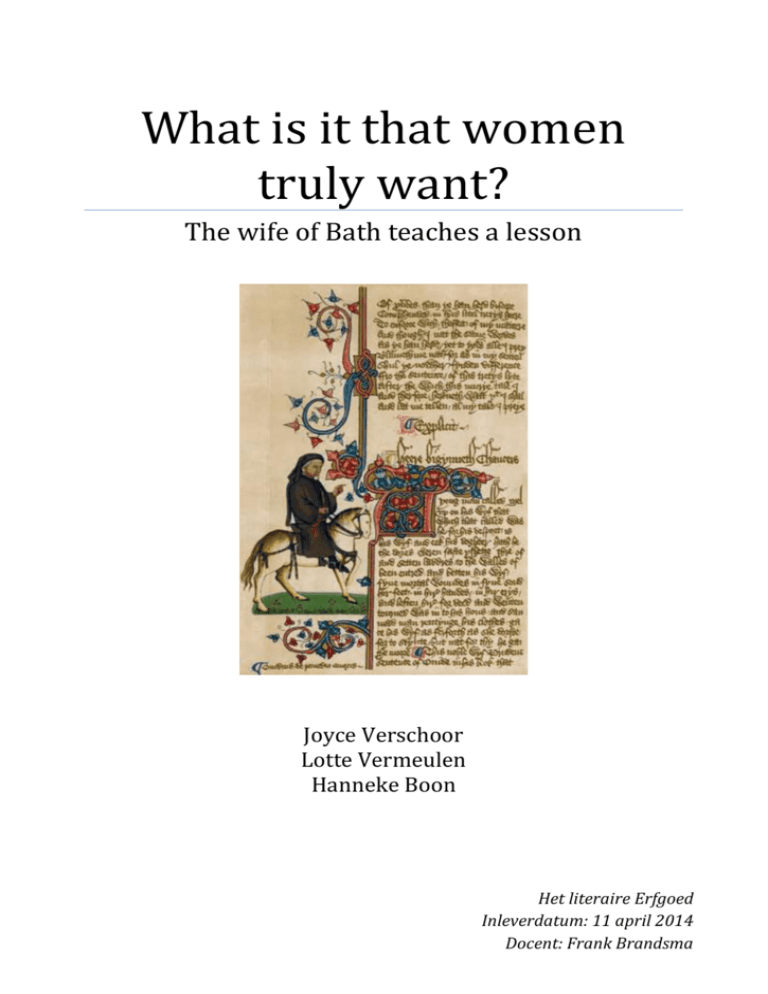
What is it that women truly want? The wife of Bath teaches a lesson Joyce Verschoor Lotte Vermeulen Hanneke Boon Het literaire Erfgoed Inleverdatum: 11 april 2014 Docent: Frank Brandsma Inhoudsopgave 1. Inleiding 2. Leerdoelen 3. De les 4. Leeractiviteit 5. Realisatie leerdoelen 6. Instructie 7. Draaiboek lesplan 8. Bijlagen - Hand-out - Correctiemodel 9. Bronnen p.3 p.4 p.5 p.6 p.7 p.8 p.9 p.12 p.13 p.20 p.22 2 Inleiding Voor veel leerlingen is middeleeuwse literatuur niet per definitie een van de meest interessante lesonderwerpen. Omdat wij vinden dat middeleeuwse literatuur wel degelijk heel erg leuk kan zijn, hebben we een interactieve les ontworpen voor een vierde klas van een tweetalig vwo (vanaf hier aangeduid als ‘tto’). Deze les is een manier om leerlingen op een interessante en interactieve manier kennis te laten maken met de middeleeuwse literatuur. De les is gebaseerd op een van de bekendste werken uit de Engelse literatuur: De Canterbury Tales, waarvan we “The Wife of Bath’s Tale” gaan bekijken. We hebben het lesplan zo geprobeerd te schrijven dat literatuur voor alle tto 4 leerlingen toegankelijk wordt, ook als deze niet direct affiniteit met literatuur hebben. Omdat er relatief weinig materiaal beschikbaar is dat specifiek voor tto-leerlingen is, hebben we gekozen om ons in dit lesplan specifiek op deze groep leerlingen te richten. Daarnaast biedt dit ons de kans om aan de slag te gaan met een uitdagende tekst. 3 Leerdoelen Bij het samenstellen van de lesonderdelen en stukken theorie hebben we de volgende leerdoelen in gedachten gehouden. Het is de bedoeling dat de leerlingen aan het einde van de les de volgende leerdoelen hebben gerealiseerd: De leerling weet wat de Canterbury Tales zijn en kan een van de verhalen in het Engels lezen, begrijpen en erover praten met medeleerlingen. De leerling maakt kennis met de leestechniek stop-and-go-reading. De leerling oefent zijn taalcompetenties: Engelse spreek- en leesvaardigheid en verteltechniek en leert te rapporteren over wat er gelezen is. De leerling maakt kennis met het middeleeuwse gedachtegoed op het gebied van schoonheidsidealen. *De leerling kan een vergelijking maken tussen de middeleeuwen en hedendaagse tijd. * Dit leerdoel wordt veelal in de extra opdrachten gerealiseerd. De meest basale versie van de les focust zich minder op dit doel. 4 De les De kennismaking met de Canterbury Tales gebeurt door het introduceren van informatie over de middeleeuwse verhalen waarna de leerlingen onder goede begeleiding van de docent grote delen van “The wife of Bath’s Tale” zullen lezen en bespreken. Op die manier krijgen de leerlingen niet alleen kennis van de tekst zelf maar leren ze ook hoe ze een middeleeuwse tekst kunnen benaderen en erover spreken met hun medeleerlingen en docent. We gaan de tekst benaderen door middel van de leestechniek ‘stop-and-go-reading’ en een drietal opdrachten. ‘Stop-and-go-reading’ is een leestechniek waarbij een stuk tekst gelezen wordt om vervolgens nog niet verder te lezen maar te stoppen en na te denken over het gelezen stuk en wat er nog moet komen. Door de tekst op te delen in verschillende stukken waar opdrachten bij zijn, bieden we de tekst in delen aan de leerlingen aan waardoor die uitgenodigd worden na elk stuk te stoppen en stil te staan bij de verkregen informatie en wat die betekent voor het verdere verloop van het verhaal. We creëren hiermee ook een nieuwsgierigheid, die kan bijdragen aan het overbrengen van de stof. Door niet alleen de te lezen tekst aan te bieden aan de leerlingen maar ook een aantal momenten aan de docent te verschaffen waarop korte informatie gegeven kan worden over hoe men leefde en dacht in de middeleeuwen, maken de leerlingen kennis met de achtergrond van de tekst. Bij het maken van het lesplan zijn wij er van uitgegaan dat de leerlingen nog geen enkele introductie hebben gehad op het gebied van middeleeuwse literatuur. We introduceren de Canterbury Tales aan het begin van de les om de leerlingen een idee te geven van waar ze mee bezig zijn. Hierbij proberen we tevens een duidelijk beeld te schetsen van de tijd waarin het verhaal geschreven is en willen we door middel van afbeeldingen de interesse prikkelen. Met het kort introduceren van de Canterbury Tales en het specifieke verhaal “The wife of Bath’s Tale” willen wij de leerlingen in korte tijd een houvast geven om de tekst goed te kunnen begrijpen. We willen bereiken dat na de les en het lezen van de tekst de leerlingen niet alleen de tekst kunnen doorgronden maar ook goed begrijpen hoe ze de tekst moeten zien en in welk kader en in welke tijd ze het verhaal moeten plaatsen. Let op, het lesplan bestaat uit drie onderdelen: het draaiboek, de hand-out en de PowerPoint. Het is de bedoeling dat alle drie de onderdelen worden benut, omdat de les anders incompleet en onduidelijk kan zijn. 5 Leeractiviteit Het was voor ons een belangrijk doel om literatuur toegankelijk te maken voor alle soorten tto-4 leerlingen. Om dit te bewerkstelligen hebben wij gekozen voor een interactieve lesmethode. Met deze methode hoeft de leerling zich niet zelfstandig door de nieuwe materie heen te werken. De leerlingen kunnen door deze les stap voor stap en samen met de docent en elkaar de tekst lezen en bespreken. Zo hopen wij dat alle leerlingen de literatuurles goed kunnen volgen en dat hun interesse geprikkeld wordt doordat ze er met elkaar over kunnen praten en op deze manier ideeën kunnen uitwisselen. In de les vinden steeds kleine ontknopingen plaats na ieder stopmoment, maar er ontstaat ook een grotere spanningsboog die begint bij de eerste opdracht en eindigt bij de ontknoping van het verhaal aan het einde van de les. Het leuke is dat de ontknoping van het verhaal niet alleen het antwoord op de vraag is die in het verhaal wordt gesteld, maar ook het antwoord op de vraag van opdracht 1. Op deze manier hebben leerlingen hun eigen zoektocht naar het antwoord gedurende de les, net als de zoektocht die in de tekst plaatsvindt. Naast de interactiviteit van de les hebben wij in onze les een afwisseling van zelf lezen en luisteren naar de door de docent voorgelezen tekst gemaakt. Zo hopen wij de aandacht erbij te kunnen houden en ook voor eventuele moeizame lezers de tekst toegankelijk te maken. Ook kan een tekst soms begrijpelijker worden voor leerlingen als de klemtoon en intonatie juist worden gelegd, zoals gebeurt wanneer de docent de tekst voorleest. Het doel van ons lesplan is literatuur toegankelijk maken en dit betekent dat wij niet willen dat een tekst samengevat, geherformuleerd of in eigen woorden verteld wordt. We willen zo dicht mogelijk bij de originele tekst blijven om de tekst zelf toegankelijk te maken en niet het verhaal dat in die tekst verteld wordt. Om die redenen hebben wij gekozen voor een vertaling van “The Wife of Bath’s Tale” in modern Engels maar wel op rijm en met hier en daar minder moderne woorden. Zo blijven we redelijk dicht bij de originele tekst maar is de tekst wel begrijpelijk voor de leerlingen. Woorden waarvan wij denken dat ze moeilijk kunnen zijn of heel belangrijk zijn voor het begrip van het verhaal worden in de kantlijn uitgelegd om een goed begrip van de tekst mogelijk te maken. Ten slotte denken wij dat literatuur toegankelijker zal worden als de leerlingen er zelfstandig over nadenken, met elkaar overleggen en zelf tot conclusies komen. Zo zijn ze zelf bezig met de tekst, terwijl de docent ervoor zorgt dat de discussies in goede banen worden geleid en de leerlingen zelf op de juiste conclusies uitkomen. 6 Realisatie leerdoelen In de les zijn verschillende elementen ingevoegd om aan de beoogde leerdoelen te kunnen voldoen. Deze worden hieronder besproken aan de hand van het betreffende leerdoel. • De leerling weet wat de Canterbury Tales zijn en kan een van de verhalen in het Engels lezen, begrijpen en erover praten met medeleerlingen. Doordat de leerling grote delen van de tekst heeft gelezen en van de rest een samenvatting heeft gehoord, krijgt de leerling de hele verhaallijn mee. Aan het einde van het lezen wordt altijd een moment ingepland waarop de leerlingen vragen kunnen stellen en waarop de docent kan controleren of alles goed begrepen is. Op deze manier wordt verzekerd dat de leerlingen het verhaal ook daadwerkelijk begrijpen. Daarnaast is er gedurende de les genoeg ruimte voor discussie en inbreng van de leerlingen, wat er voor zorgt dat de leerlingen actief met elkaar praten over de behandelde stof. • De leerling maakt kennis met de leestechniek stop-and-go-reading. De gehele les is gebaseerd op de leestechniek stop-and-go-reading. Op deze manier maken de leerlingen kennis met deze manier van lezen. • De leerling oefent zijn taalcompetenties: Engelse spreek- en leesvaardigheid en vertelvermogen en leert te rapporteren over wat er gelezen is. Omdat de gehele les in het Engels wordt gegeven, de teksten in het Engels worden gelezen en de discussies in het Engels gevoerd worden, wordt een aantal belangrijke competenties van het beheersen van een vreemde taal geoefend: lezen, spreken en luisteren. • De leerling maakt kennis met het middeleeuwse gedachtegoed op het gebied van schoonheidsidealen. De tekst die de leerlingen lezen, is in vele opzichten representatief voor de middeleeuwen. Daarnaast worden er stukken theorie verschaft over gebruiken toentertijd, om de leerlingen een beeld te geven van het middeleeuwse gedachtegoed op het gebied van schoonheid. • tijd. *De leerling kan een vergelijking maken tussen de middeleeuwen en hedendaagse Door bij middeleeuwse gebruiken aan de leerlingen te vragen hoe wij daar tegenwoordig mee om gaan, maakt de leerling automatisch een vergelijking. Dit is niet alleen goed voor de realisatie van de verschillen tussen de middeleeuwen en hedendaagse tijd, maar het kan ook zorgen dat de stof beter blijft hangen omdat het betrekken op het nu meer indruk maakt. 7 Instructie Deze les kan worden gegeven als aanvulling op een reguliere literatuurles in een tweetalige vwo-klas of als literatuurles bij het vak Engels bij een reguliere vwo-klas. Omdat de meest basale versie van de les ongeveer 60 minuten duurt, zal deze gemakkelijk in een of twee lessen te geven zijn. Er zijn echter genoeg extra opdrachten toegevoegd om dieper op het onderwerp in te kunnen gaan en langer met het onderwerp bezig te zijn. Daarnaast is het mogelijk om creatief met het lesmateriaal om te springen door bijvoorbeeld de stukken theorie uit te breiden of de discussies langer te maken. In het lesplan worden een aantal optionele vragen aangeboden waarbij de docent per klas kan bepalen of deze vragen wel of niet behandeld zullen worden. De optionele vragen kunnen voor extra diepgang in de les zorgen maar zijn naar onze mening moeilijker te beantwoorden en kosten dus meer tijd dan de reguliere vragen. Door de optionele vragen te gebruiken tijdens de les, wordt een extra leerdoel nagestreefd namelijk: Een vergelijking kunnen maken tussen de middeleeuwen en hedendaagse tijd. De andere optionele vragen dienen ter verdieping van de behandelde stof en zodoende zorgen zij voor een verdere realisering van de leerdoelen. We hebben ervoor gekozen om de les zelf op een zo kort en duidelijk mogelijke manier te presenteren in een draaiboek. Door bondige en concrete instructies te geven is het voor de docent makkelijk om het lesplan erbij te houden zonder verdwaald te raken in de tekst. Vanwege het feit dat de les in het Engels gegeven gaat worden, is het draaiboek in het Engels geschreven. Op die manier hoeft de docent niet van taal te wisselen, aangezien dit verwarrend kan zijn. Tips: -Het kan leuk zijn om als aanvulling op de les, of als introductie van de les een stukje van de film “What women want” uit 2000 (regisseur Nancy Meyers) te draaien met in de hoofdrollen Mel Gibson en Helen Hunt. Op deze manier wordt de aandacht getrokken en is het duidelijk voor de leerlingen wat de tegenwoordige relevantie van het onderwerp van de tekst is. - Alle antwoorden die op het bord worden geschreven gedurende de les kunnen worden uitgeveegd, maar bij opdracht 1 is het leuker om de antwoorden te laten staan. Aan het einde van de les komt de ontknoping van opdracht 1 en door de antwoorden te laten staan blijft het voor de leerlingen spannend. - De stukjes theorie zijn een richtlijn maar het kan een leuk idee zijn om de informatie aan te vullen of een eigen interpretatie neer te zetten. Dit kan ook een manier zijn om de les wat uit te breiden, mocht hier tijd voor zijn. 8 Sterretje *: optionele opdracht Schuin gedrukt: handeling Cijfers voor de tekst (cijfer): nummer van de powerpoint-slide TO: de docent leest voor en de leerlingen lezen mee met de hand-out AL: de leerlingen lezen zelfstandig de tekst TE: de docent leest alleen voor Draaiboek lesplan Introduction: * Ask for the knowledge of the topic. Ask what the students already know about it. Introduce the Canterbury Tales briefly. (The text below could be used, or an own interpretation if desired. ) “The Canterbury Tales is the name of a work written by Geoffrey Chaucer. The work tells us of a pilgrimage where the pilgrims tell each other stories to entertain themselves during the long trip on a horseback. These stories and the characters that tell them give us an overview of the society in England in the fourteenth century, the century in which the work was written. One of the pilgrims who tells a story is a housewife from Bath and the story she tells is called: The wife of Bath’s Tale.” (2) Show a piece of manuscript Interactive lesson TO: Read text 1 Enquire what attracted the students’ attention in the text (If students do not notice the fact that the piece is in rhyme, fill in) Tell students why the text is in rhyme (The text below could be used, or an own interpretation if desired. ) “The text is in rhyme. This made it easier to remember the story when someone read it in silence or when it was performed by a storyteller.” Enquire whether the students understood the story by asking what they have just read. Summarize the text together with the students and fill in where necessary. Exercise 1: (3) “I’ll grant you life if you can tell me what it is that women most desire.” (r. 904-905) 9 Ask students what they think that women most desire nowadays and write the answers down on the blackboard. TO: Read text 2 (Emphasize that the text is about people who were asked the same question, but in the middle ages.) Divide the class into two groups: boys and girls. Make the groups come up with one answer each, to the following question: What did women most desire in the middle ages? Write the two answers down on the board. Don’t erase! TE: Read the following summary to the students After twelve months the knight still has not found the answer but he has to return to the queen. By chance he rides along a forest where he sees a group of ladies dancing. When he moves closer to ask them what it is that women most desire, they all disappear except for one ugly, old lady. The knight tells her about his question and she assures him that she will teach him the right answer, but only under one condition: the knight must do the first thing she requests of him. The knight gives the old lady his promise and they ride to the court. After arriving at court, the knight, prompted by the hag, gives the correct answer to the question and the queen decides to spare his life.1 After the knight has given the answer, the old lady reminds the knight of his oath and requests that he marries her. Although the knight does not at all feel like marrying her, he has no choice since he gave her his word. The two soon get married and go to bed together. Exercise 2 AL: The students read text 3 (4) Have the students answer the following question(s) and write the answers on the board. How does the knight feel about the woman? * How does the woman feel about the knight? 1 The right answer will deliberately NOT be told. In this way, the correct answer will be a question until the end of the lesson. 10 Tell the students about the standards in the middle ages. (The text below could be used, or an own interpretation if desired. ) As we saw in the text, the knight doesn’t want to be with the woman because she is ugly, old and has a low social status from birth. This fits into the medieval ideals of women and marriage in the following ways: A rich and noble knight would have degraded himself if he married a woman from a lower social status. Marrying with a high class woman would have been very good for one’s status and position in society. Marrying a lower class woman would not. Medieval people thought that your outer beauty reflected your inner beauty. So if you were ugly, you would have had an ugly character too, according to them. A woman was considered beautiful when she, among other things, had a white skin. The white skin shows that a woman did not expose her skin to sunlight, which means she didn’t have to work on the land. Apart from the white skin a woman had to have blond hair and a round face to be considered beautiful according to medieval standards. (5) *Ask the students if they think that the modern beauty standards and the medieval beauty standards are alike: What are the modern beauty standards? What are the differences between beauty standards nowadays and in the middle ages? What are the similarities? Exercise 3 TO: Read text 4 (6) Ask the students what options the knight has to choose from and write them on the board (7) Divide the students into groups of 4 or 5 and have them discuss the following questions: What would be the best choice according to you? What do you think the knight will choose? Write the answers to both of the questions on the board per group. TO: Read text 5 (8) Discuss the end of the story with the students and make sure all students understand the text. Ask them what happened and fill in everything they don’t understand. How do they feel about the outcome? Did they expect the answer? Was it similar to their answers? *Ask the students what kind of questions they would have made up for this particular test, if they were to be a teacher. 11 Bijlagen Bij het lesplan horen twee bijlagen; een hand-out en een correctiemodel. De hand-out bevat de verschillende teksten (tekst 1 t/m 5) die voor de opdrachten nodig zijn en is bedoeld voor zowel de leerlingen als de docent. De leerlingen hebben zo de gelegenheid zelfstandig de teksten mee te lezen terwijl de docent de hand-out gebruikt om de teksten voor te lezen. De hand-out kan gekopieerd worden en moet worden uitgedeeld, alvorens de les te beginnen. Daarnaast hebben we een correctiemodel gemaakt waarin de antwoorden staan op de vragen waarover twijfel zou kunnen ontstaan. Zo kan de docent snel de antwoorden vinden om er met de leerlingen verder over te spreken. In het correctiemodel zullen eerst de opdrachten en vragen genoemd worden zoals die ook in het draaiboek van het lesplan voorkomen waarna de uitleg en antwoorden zullen volgen. 12 The Wife of Bath's Tale Text 1 In the old days of King Arthur, today Still praised by Britons in a special way, This land was filled with fairies all about. The elf-queen with her jolly little rout In many a green field often danced. Indeed This was the old belief of which I read; I speak of many hundred years ago. But now such elves no one is seeing. No, For now the prayers and charitable desires Of limiters and other holy friars Who wander all the land, by every stream, As thick as specks of dust in a sunbeam, To bless our halls, chambers, kitchens, bowers, Boroughs, cities, castles, lofty towers, Villages, granaries, stables, dairies, Have made sure that no longer are there fairies. For where there once was wont to walk an elf There's walking now the limiter himself, Early and late, to give his auspices, 875 Say matins and his other offices, Go all about the limit where he's found. Now women may go safely all around; In every bush and under every tree He is the only incubus, and he Won't do a thing except dishonour them. It happened that King Arthur had with him A bachelor in his house; this lusty liver, While riding from his hawking by the river, Once chanced upon, alone as she was born, A maiden who was walking--soon forlorn, For he, despite all that she did or said, By force deprived her of her maidenhead. Because of this, there was such clamouring And such demand for justice to the king, This knight was all but numbered with the dead By course of law, and should have lost his head (Which may have been the law in that milieu). But then the queen and other ladies too Prayed so long that the king might grant him grace, King Arthur spared him for at least a space; He left him to the queen to do her will, To choose to save or order them to kill. The queen then thanked the king with all her might, 13 the British 860 cheerful company 865 Types of monk who have chosen a life of beggingmonk 870 districts grain storage support, protection morning prayer 880 885 male demon man who has never married organ, formerly supposed to be the seat of love and violent emotion virginity 890 895 here: a while And after this the queen spoke with the knight When she saw opportunity one day. "For you," she said, "things stand in such a way You can't be sure if you're to live or not. I'll grant you life if you can tell me what It is that women most desire. Beware The iron axe, your neckbone now to spare! And if you cannot tell me right away, I'll give you leave, a twelvemonth and a day, That you may go to seek, that you might find An answer that is of sufficient kind. I want your word before you take a pace: You'll bring yourself back to this very place." This knight with sorrow sighed, was full of woe. What could he do? Not as he pleased, and so To go away was what he finally chose, To come back when his year was at its close With such an answer as God might provide. He took his leave and forth he went to ride. He sought in every house and every place In hopes he could secure the promised grace By learning that which women love the most. But he did not arrive at any coast Where he could find two people on the matter Who might agree, if judging by their chatter. 14 900 905 910 misery 915 forward 920 absolution informal talk about unimportant topics Text 2 Some said that women all love riches best, While some said honour, others jolly zest, Some rich array; some said delights in bed, And many said to be a widow wed; Some others said that our hearts are most eased When we are flattered and when we are pleased-And he was nigh the truth, if you ask me. A man shall win us best with flattery; With much attendance, charm, and application Can we be caught, whatever be our station. Some said our love to which we all aspire Is to be free to do as we desire, With no reproof of vice but with the rule That men should say we're wise, not one a fool. For truly there is none among us all Who, if a man should claw us on the gall, Won't kick for being told the truth; he who Does an assay will find out that it's true. But though we may have vices kept within, We like to be called wise and clean of sin. And some say that we take the most delight In keeping secrets, keeping our lips tight, To just one purpose striving to adhere: Not to betray one thing that we may hear. That tale's not worth the handle of a rake. We women can't keep secrets, heaven's sake! 15 925 enthusiasm here: beautiful clothing 930 close to (social) position 935 blame of shortcomings 940 945 950 catch us on our bad character traits attempt Text 3 He tossed and then he turned both to and fro. His old wife lay there smiling at him, though, And said, "Dear husband, benedicite! Acts every knight toward his wife this way? Is this the law of great King Arthur's house? Is every knight of his so distant? Spouse, I am your own true love and I'm your wife And I'm the one as well who saved your life, And I have never done you wrong or spite. Why do you treat me so on our first night? You act just like a man who's lost his wit. What is my guilt? For God's love, tell me it, And it shall be amended if I may." "Amended?" asked the knight. "Whatever way? There's no way it could ever be amended. You are so old and loathsome--and descended, To add to that, from such a lowly kind-No wonder that I toss and turn and wind. I wish to God my heart would burst, no less!" "Is this," she said, "the cause of your distress?" "Why, yes," said he, "and is there any wonder?" She said, "I could amend the stress you're under, If you desire, within the next three days, If you'll treat me more kindly in your ways. "But when you talk about gentility Like old wealth handed down a family tree, That this is what makes of you gentlemen, Such arrogance I judge not worth a hen. Take him who's always virtuous in his acts In public and in private, who exacts Of himself all the noble deeds he can, And there you'll find the greatest gentleman. Christ wills we claim nobility from him, Not from our elders or the wealth of them; For though they give us all their heritage And we claim noble birth by parentage, They can't bequeath--all else theirs for the giving-To one of us the virtuous way of living That made the nobles they were known to be, The way they bade us live in like degree. [...] And so, dear husband, thus I will conclude: If it's true my ancestors were so rude, Yet may the Lord, as I do hope, grant me The grace to live my life most virtuously; 16 1085 back and forth God bless you! 1090 husband 1095 senses corrected 1100 repulsive (ugly) of poor origin 1105 nobility 1110 demands 1115 ancestors 1120 Leave something to a person by a will instructed honest/good For I'm a noble when I so begin To live in virtue and avoid sin. "For poverty you scold me. By your leave, The God on high, in whom we both believe, Chose wilfully to live a poor man's life; And surely every man, maiden, or wife Can understand that Jesus, heaven's King, Would not choose sinful living. It's a thing Of honour to be poor without despair, As Seneca and other clerks declare. [...] Poverty is an eyeglass, I contend, Through which a man can see a truthful friend. I bring no harm at all to you, therefore Do not reprove me, sire, for being poor. For being old you've also fussed at me; Yet surely, sire, though no authority Were in a book, you gentlemen select Say men should treat an elder with respect And call him father, by your courtesy. I think I could find authors who agree. 17 1175 blame 1180 scholar 1205 1210 person of admirable age politeness Text 4 "If I am old and ugly, as you've said, Of cuckoldry you needn't have a dread; For filthiness and age, as I may thrive, Are guards that keep one's chastity alive. But nonetheless, since I know your delight, I shall fulfil your worldly appetite. "Choose now," she said, "one of these two: that I Be old and ugly till the day I die, And be to you a true and humble wife, One never to displease you all your life; Or if you'd rather, have me young and fair, And take your chance on those who will repair To your house now and then because of me (Or to some other place, it may well be). Choose for yourself the one you'd rather try." The knight gave it some thought, then gave a sigh, And finally answered as you are to hear: 18 adultery 1215 state of refraining from sex what you take pleasure in a strong liking for something 1220 go to 1225 Text 5 "My lady and my love and wife so dear, I leave to your wise governance the measure; You choose which one would give the fullest pleasure And honour to you, and to me as well. I don't care which you do, you best can tell. What you desire is good enough for me." "You've given me," she said, "the mastery? The choice is mine and all's at my behest?" "Yes, surely, wife," said he, "I think it best." "Then kiss me, we'll no longer fight," she said, "For you've my oath that I'll be both instead-That is to say, I'll be both good and fair. I pray to God I die in mad despair Unless I am to you as good and true As any wife since this old world was new. Come dawn, if I'm not as fair to be seen As any lady, empress, any queen Who ever lived between the east and west, Then take my life or do whatever's best. Lift up the curtains now, see how it is." And when the knight had truly seen all this, How she was young and fair in all her charms, In utter joy he took her in his arms; His heart was bathing in a bath of bliss, A thousand kisses he began to kiss, And she obeyed in each and every way, Whatever was his pleasure or his play. And so they lived, till their lives' very end, In perfect joy. And may Christ Jesus send Us husbands meek and young and fresh abed, And then the grace to outlive those we wed; I also pray that Jesus shorten lives Of those who won't be governed by their wives; As for old niggards angered by expense, God send them soon a mighty pestilence! 19 1230 command 1235 command 1240 1245 1250 perfect happiness 1255 obedient 1260 epidemic of plague Correctiemodel Enquire what attracted the students’ attention in the text (If students do not notice the fact that the piece is in rhyme, fill in) - The students can mention a lot of things they noticed in the text. It is easy to verify the answers by looking at the text. The most important answer, however, is that the text is in rhyme. If the students don’t notice this, the teacher must fill in. Ask students what they think that women most desire nowadays and write the answers down on the board. - The students can give any answer they want about what they think that women most desire nowadays. Divide the class into two groups: boys and girls. Make the groups come up with one answer each, to the following question: What did women most desire in the middle ages? - The answers to this question are to be found in text 2. Any answer the students come up with can be correct provided that it is taken from the text. Have the students answer the following question(s) and write the answers on the board. How does the knight feel about the woman? * How does the woman feel about the knight? - The knight finds the woman repulsive for she is old, ugly, poor and from low birth. - * The woman finds the knight arrogant and not at all a noble man. In a more profound analysis of the text the students can find the following answers: The woman tells the knight that true nobility doesn’t come from richness or noble birth. A noble life is when a person lives in virtue and avoids sin. Poverty or origin shouldn’t matter for the knight, it should be enough for him that his wife led a virtuous life and he should do the same. A noble man should have respect for elderly, the knight thus has no right to treat his wife so badly because of her old age. * Ask the students if they think that the modern beauty standards and the medieval beauty standards are alike: What are the modern beauty standards? What are the differences between beauty standards nowadays and in the middle ages? 20 What are the similarities? - * Any answer is allowed for this questions, it is up to the creativity of the students as long as the information just provided about the medieval standards is used. Ask the students what options the knight has to choose from and write them on the board - The options the knight can choose from are the following: 1. His wife will stay old and ugly but will be true to him in her love. 2. His wife will become beautiful and young but will commit adultery whenever she can. Divide the students into groups of 4 or 5 and have them discuss the following questions: What would be the best choice according to you? What do you think the knight will choose? - The students can give any answer they want to this question. At this question the students can think of their own answers as long as they can put forward arguments from what they just learned and read. *Ask the students what kind of questions they would have made up for this particular test, if they were to be a teacher. - * The students can come up with any answer they want since it is up to their own creativity in this exercise. 21 Bronnen Voor de afbeelding van het manuscript hebben wij gebruik gemaakt van de volgende internetbron: - <http://3.bp.blogspot.com/3x4s1CnvxFg/UtEkwWcbCJI/AAAAAAAAGu0/AOkk3uIwg2Q/s1600/chaucer+palace.jp g> Voor de stukken theorie hebben wij de volgende bronnen geraadpleegd: - Ovidius. Vertaald door: M. d’Hane-Scheltema. Lessen in liefde. Verzen over de liefde en de erotiek. Amsterdam: Athenaeum – Polak & Van Gennep, 2004. “The concept of women beauty over the centuries.” Evoscience. 11 april 2014 <http://www.evoscience.com/concept-women-beauty-centuries/> 22
